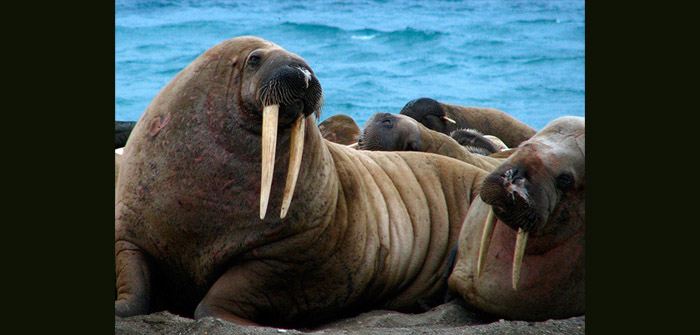(Walrus provide a subsistence lifestyle, food source along the Western Coast of Alaska. They also figure prominently in the art of all three artists | Photo courtesy of Raven Makes Gallery)
Don Johnston, Aleut, moved to Anchorage from Ketchikan, Alaska 35 years ago to work construction but suffered a somewhat fortuitous back injury. While recovering, he meet the highly acclaimed Inupiaq baleen basket weaver James Omnik Sr. James taught him the art and Don eventually became so skilled that some are now heralding him as perhaps the finest baleen basket weaver ever.
Baleen baskets are literally woven with the filtering plates found inside the mouth of krill eating whales. Baleen has strength and flexibility comparable to fiberglass, so attempting to weave a small, intricate basket of this rigidity demands strength and fine motor dexterity at the same time. Typically, an elegantly carved walrus ivory handle or finial sits atop the basket’s lid.
Don’s contemporary perspectives on the traditional art form not only explore the possibilities of what baleen baskets can be but led him to capture the 2017 Best of Show Award at the renowned and juried Native American art show — the Heard Museum Indian Fair and Market in Phoenix, Arizona. Seldom does an artist from Alaska gain entrance to this annual event; to win Best of Show is unprecedented.
Mark Tetpon, Inupiaq, is a wood-ivory-bone master carver who is virtually unknown outside of Alaska and the Pacific Northwest. He has done numerous shows in Anchorage and Seattle, where his pieces are quickly acquired, thus secreting away knowledge of his works and awareness about his prodigious talent.
Mark’s pieces depict sea mammals or birds as they are understood within the spiritual realms of his people. A sculptured polar bear or walrus might be drumming; an honoring mask that depicts a loon or seal’s body will be surrounded by a dozen smaller sculptures paying homage to the life of The People.
Mark’s father, John, from the traditional village of Shaktoolik along the Bering Sea Coast near Nome, mentored him in the ways of the Inupiaq people and during Mark’s early artistic endeavors. John still assists Mark with some of his pieces.
Bronze and ceramic sculptor Terresa White, Yu’pik Eskimo, is being lauded as one of the blossoming talents in the Native American art world. Her fresh perspectives on the ancient Yup’ik belief of transformation garnered a Best of Sculpture Award in 2018 at the Santa Fe Indian Market, the other apex event for Native American art venues.
Transformation concerns the traditional Yup’ik belief that a human can at least spiritually, if not also physically, become an animal — and vice versa — if proper behaviors are maintained. Thus, humans and the animals reside in a type of metaphysical brother/sisterhood coexistence. Terresa’s works honor the interconnection of all beings, often focusing on the defining moments of the metamorphosis.
The twenty-one Peoples compromising ‘Alaska Natives’ come from one of three primary populations — The five Northern, Western, or Southern Coastal Region Peoples, related by language or traditional culture; The twelve Athabascan Peoples of Interior Alaska, language and culturally related; The four ‘Northwest Coast’ Peoples of Alaska’s Southeastern Archipelago, who have diverse languages but similar cultures.
Alaska Natives are comparable to the three language groups of Europe—the Romance, Germanic, and Slavic Nations. Each has varying languages and socio-political perspectives, but the cultures within these three groups remain relatively similar. The artwork of Don, Teresa, and Mark—Aleut, Yup’ik, Inupiaq—have similarities while being distinctly different from that of the Athabascan and Northwest Coast groups.
These artists will be offering an in-person show in Sisters April 26-28, with — an Artist Reception on Friday from 4pm to 7pm and an art making demonstration on Saturday. All events will take place at Raven Makes Gallery at 182 E Hood Avenue.

